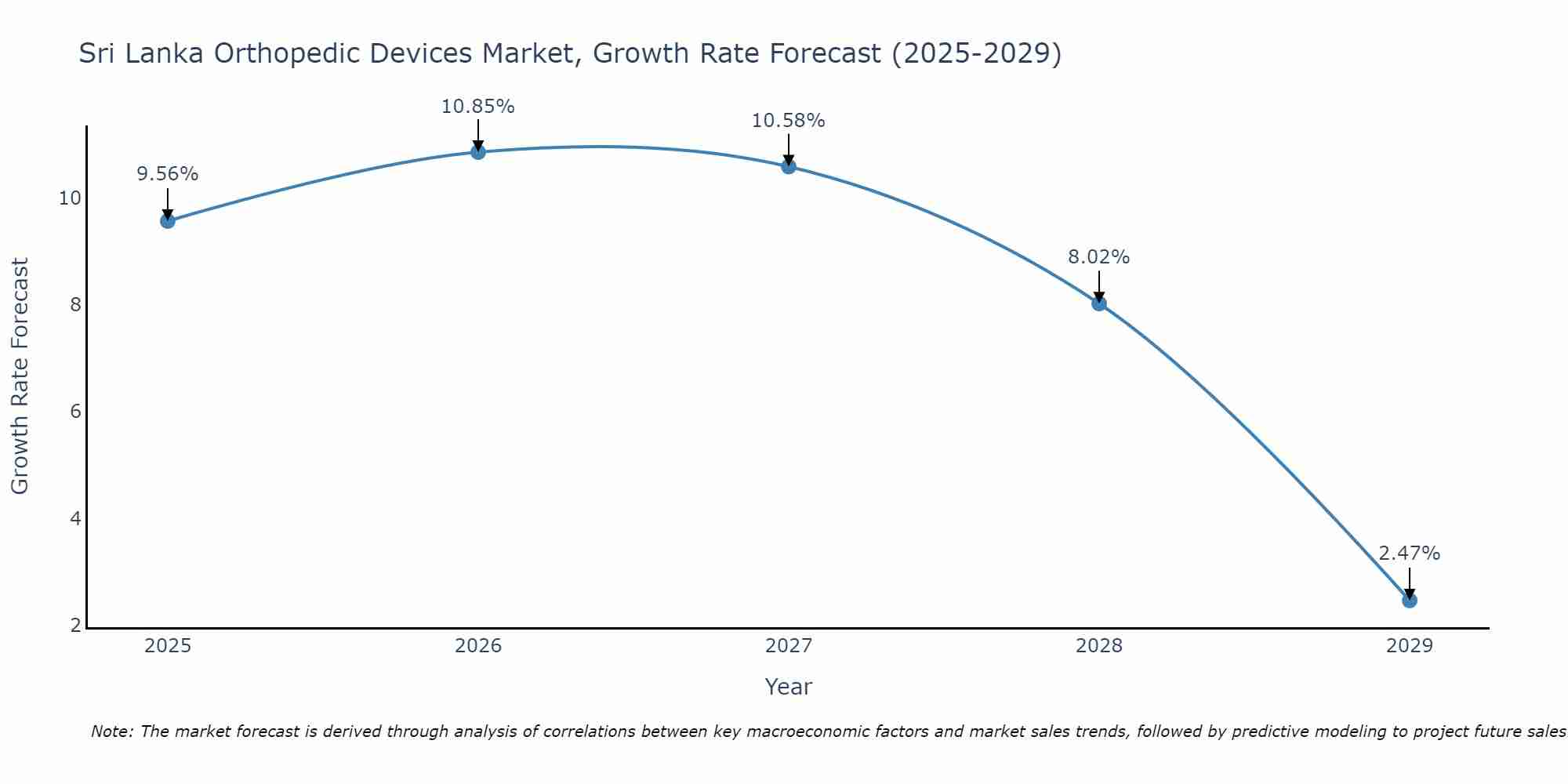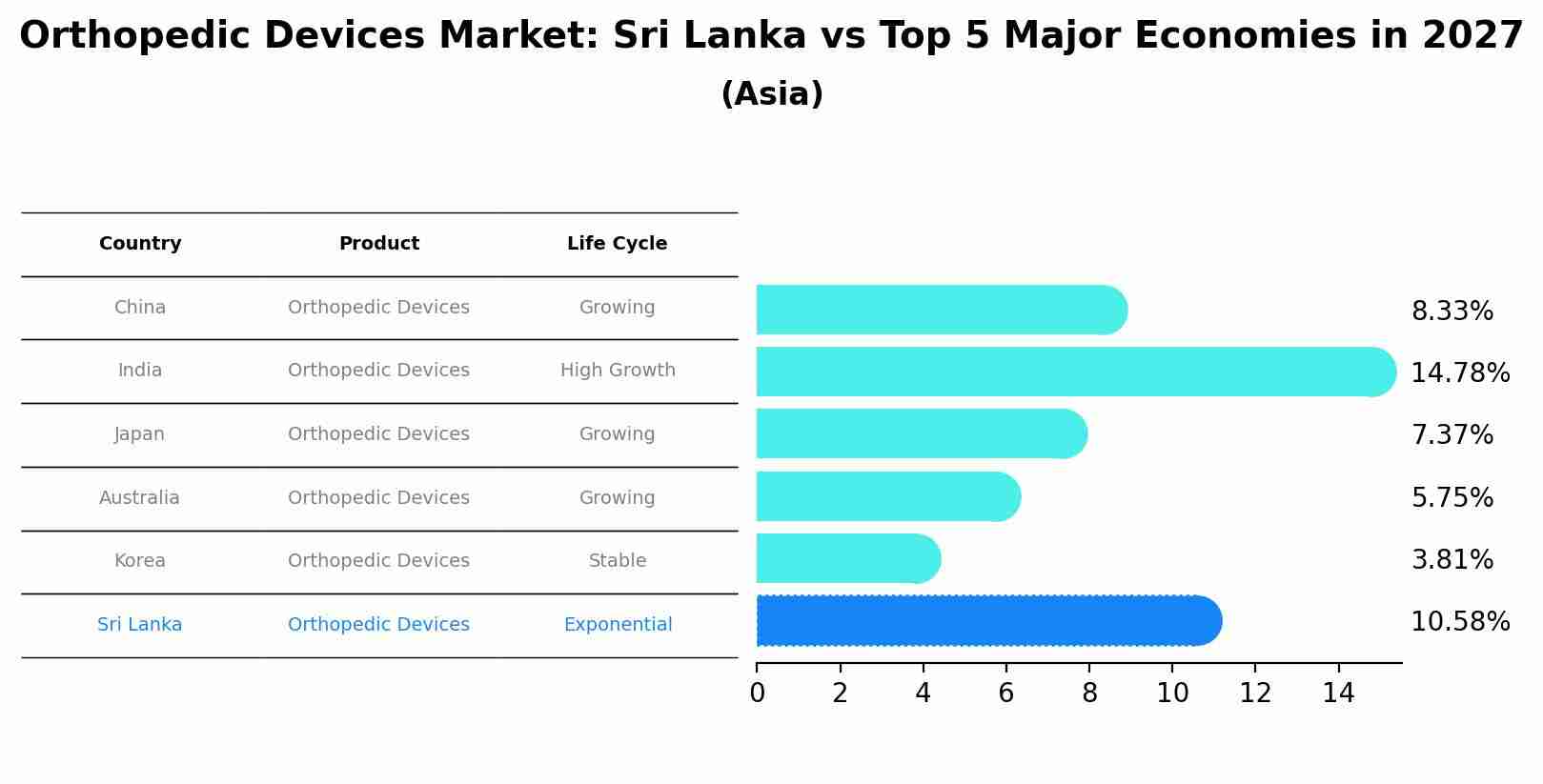Sri Lanka Orthopedic Devices Market Outlook | Size, Value, Analysis, Companies, Forecast, Trends, Growth, Revenue, Share, Industry & COVID-19 IMPACT
| Product Code: ETC368131 | Publication Date: Aug 2022 | Updated Date: Jul 2025 | Product Type: Market Research Report | |
| Publisher: 6Wresearch | Author: Vasudha | No. of Pages: 75 | No. of Figures: 35 | No. of Tables: 20 |
Sri Lanka Orthopedic Devices Market Size Growth Rate
The Sri Lanka Orthopedic Devices Market is projected to witness mixed growth rate patterns during 2025 to 2029. Growth accelerates to 10.85% in 2026, following an initial rate of 9.56%, before easing to 2.47% at the end of the period.

Orthopedic Devices Market: Sri Lanka vs Top 5 Major Economies in 2027 (Asia)
By 2027, the Orthopedic Devices market in Sri Lanka is anticipated to reach a growth rate of 10.58%, as part of an increasingly competitive Asia region, where China remains at the forefront, supported by India, Japan, Australia and South Korea, driving innovations and market adoption across sectors.

Sri Lanka Orthopedic Devices Market Synopsis
The Sri Lanka Orthopedic Devices Market is a growing sector due to the country`s aging population and increasing prevalence of orthopedic conditions. The market includes a wide range of products such as joint reconstruction devices, spinal implants, trauma fixation devices, orthobiologics, and orthopedic accessories. Key drivers of market growth include advancements in technology, rising disposable income levels, and a growing awareness of orthopedic treatments. The market is primarily dominated by multinational companies, but local manufacturers are also gaining prominence. Government initiatives to improve healthcare infrastructure and the increasing demand for minimally invasive surgeries are expected to further fuel market growth in Sri Lanka. However, challenges such as limited reimbursement policies and high costs of orthopedic procedures may hinder market expansion to some extent.
Sri Lanka Orthopedic Devices Market Trends
The Sri Lanka Orthopedic Devices Market is experiencing notable trends such as the increasing prevalence of musculoskeletal disorders due to aging population and sedentary lifestyles. There is a growing demand for minimally invasive orthopedic procedures, leading to the adoption of advanced technologies such as robotic-assisted surgeries. The market is also witnessing a rise in the development of innovative orthopedic devices, including implants and prosthetics, to cater to the specific needs of patients. Additionally, the emphasis on improving healthcare infrastructure and increasing healthcare expenditure in Sri Lanka is contributing to the growth of the orthopedic devices market. Overall, the market is expected to continue expanding as the country`s healthcare sector evolves to meet the demands of a growing population with orthopedic conditions.
Sri Lanka Orthopedic Devices Market Challenges
In the Sri Lanka Orthopedic Devices Market, there are several challenges faced by industry players. These include limited access to advanced technology and equipment, leading to a reliance on imports which can drive up costs. Additionally, there is a shortage of skilled professionals such as orthopedic surgeons and technicians, impacting the quality of care provided. Infrastructure limitations in terms of healthcare facilities and specialized orthopedic centers also pose challenges in delivering timely and efficient services to patients. Regulatory hurdles and compliance issues further complicate the market landscape, affecting market entry and product approvals. Overall, addressing these challenges will be crucial in improving the overall quality of orthopedic care in Sri Lanka and driving sustainable growth in the market.
Sri Lanka Orthopedic Devices Market Investment Opportunities
The Sri Lanka Orthopedic Devices Market presents promising investment opportunities due to the growing demand for advanced orthopedic devices driven by an aging population, increasing prevalence of orthopedic disorders, and rising healthcare expenditure. Investors can consider opportunities in segments such as joint reconstruction implants, spinal devices, trauma fixation devices, orthobiologics, and orthopedic accessories. Companies offering innovative technologies, minimally invasive procedures, and customized solutions are likely to attract interest in this market. Additionally, strategic partnerships with local healthcare providers, expansion of distribution networks, and investments in research and development to introduce novel products tailored to the Sri Lankan market can help investors capitalize on the growing orthopedic devices sector in the country.
Jordan Agar Market Government Policies
The Sri Lankan government has implemented various policies to regulate the Orthopedic Devices Market. The Medical Devices Act of 2015 establishes guidelines for the registration, importation, manufacturing, and distribution of orthopedic devices to ensure quality and safety standards are met. The government also requires all medical devices, including orthopedic devices, to be registered with the Medical Devices Regulatory Authority (MDRA) before they can be imported or sold in the country. Additionally, the government provides incentives for local manufacturing of medical devices to promote self-sufficiency and reduce reliance on imports. Overall, these policies aim to ensure the availability of high-quality orthopedic devices in the market while safeguarding the health and well-being of patients in Sri Lanka.
Sri Lanka Orthopedic Devices Market Future Outlook
The future outlook for the Sri Lanka Orthopedic Devices Market is promising, driven by factors such as the increasing geriatric population, rising prevalence of orthopedic disorders, and improving healthcare infrastructure in the country. The demand for orthopedic devices is expected to grow as more people seek advanced treatments for orthopedic conditions. Additionally, technological advancements in orthopedic devices, such as 3D printing and robotic-assisted surgeries, are likely to further drive market growth. However, challenges such as limited access to specialized orthopedic care in rural areas and regulatory hurdles may impact market expansion. Overall, the Sri Lanka Orthopedic Devices Market is anticipated to witness steady growth in the coming years, presenting opportunities for market players to innovate and introduce advanced solutions to cater to the evolving healthcare needs of the population.
Key Highlights of the Report:
- Sri Lanka Orthopedic Devices Market Outlook
- Market Size of Sri Lanka Orthopedic Devices Market, 2021
- Forecast of Sri Lanka Orthopedic Devices Market, 2031
- Historical Data and Forecast of Sri Lanka Orthopedic Devices Revenues & Volume for the Period 2018 - 2031
- Sri Lanka Orthopedic Devices Market Trend Evolution
- Sri Lanka Orthopedic Devices Market Drivers and Challenges
- Sri Lanka Orthopedic Devices Price Trends
- Sri Lanka Orthopedic Devices Porter's Five Forces
- Sri Lanka Orthopedic Devices Industry Life Cycle
- Historical Data and Forecast of Sri Lanka Orthopedic Devices Market Revenues & Volume By Application for the Period 2018 - 2031
- Historical Data and Forecast of Sri Lanka Orthopedic Devices Market Revenues & Volume By Hip Orthopedic Devices for the Period 2018 - 2031
- Historical Data and Forecast of Sri Lanka Orthopedic Devices Market Revenues & Volume By Knee Orthopedic Devices for the Period 2018 - 2031
- Historical Data and Forecast of Sri Lanka Orthopedic Devices Market Revenues & Volume By Spine Orthopedic Devices for the Period 2018 - 2031
- Historical Data and Forecast of Sri Lanka Orthopedic Devices Market Revenues & Volume By Craniomaxillofacial Orthopedic Devices for the Period 2018 - 2031
- Historical Data and Forecast of Sri Lanka Orthopedic Devices Market Revenues & Volume By Dental Orthopedic Devices for the Period 2018 - 2031
- Historical Data and Forecast of Sri Lanka Orthopedic Devices Market Revenues & Volume By Sports Injuries, Extremities And Trauma (Set) Orthopedic Devices for the Period 2018 - 2031
- Historical Data and Forecast of Sri Lanka Orthopedic Devices Market Revenues & Volume By Product for the Period 2018 - 2031
- Historical Data and Forecast of Sri Lanka Orthopedic Devices Market Revenues & Volume By Drill Guide for the Period 2018 - 2031
- Historical Data and Forecast of Sri Lanka Orthopedic Devices Market Revenues & Volume By Guide Tubes for the Period 2018 - 2031
- Historical Data and Forecast of Sri Lanka Orthopedic Devices Market Revenues & Volume By Implant Holder for the Period 2018 - 2031
- Historical Data and Forecast of Sri Lanka Orthopedic Devices Market Revenues & Volume By Custom Clamps for the Period 2018 - 2031
- Historical Data and Forecast of Sri Lanka Orthopedic Devices Market Revenues & Volume By Distracters for the Period 2018 - 2031
- Historical Data and Forecast of Sri Lanka Orthopedic Devices Market Revenues & Volume By Screw Drivers for the Period 2018 - 2031
- Historical Data and Forecast of Sri Lanka Orthopedic Devices Market Revenues & Volume By Accessories for the Period 2018 - 2031
- Sri Lanka Orthopedic Devices Import Export Trade Statistics
- Market Opportunity Assessment By Application
- Market Opportunity Assessment By Product
- Sri Lanka Orthopedic Devices Top Companies Market Share
- Sri Lanka Orthopedic Devices Competitive Benchmarking By Technical and Operational Parameters
- Sri Lanka Orthopedic Devices Company Profiles
- Sri Lanka Orthopedic Devices Key Strategic Recommendations
Frequently Asked Questions About the Market Study (FAQs):
- Single User License$ 1,995
- Department License$ 2,400
- Site License$ 3,120
- Global License$ 3,795
Search
Related Reports
- Vietnam System Integrator Market (2025-2031) | Size, Companies, Analysis, Industry, Value, Forecast, Growth, Trends, Revenue & Share
- ASEAN and Thailand Brain Health Supplements Market (2025-2031) | Strategy, Consumer Insights, Analysis, Investment Trends, Opportunities, Growth, Size, Share, Industry, Revenue, Segments, Value, Segmentation, Supply, Forecast, Restraints, Outlook, Competition, Drivers, Trends, Demand, Pricing Analysis, Competitive, Strategic Insights, Companies, Challenges
- ASEAN Bearings Market (2025-2031) | Strategy, Consumer Insights, Analysis, Investment Trends, Opportunities, Growth, Size, Share, Industry, Revenue, Segments, Value, Segmentation, Supply, Forecast, Restraints, Outlook, Competition, Drivers, Trends, Demand, Pricing Analysis, Competitive, Strategic Insights, Companies, Challenges
- Europe Flooring Market (2025-2031) | Outlook, Share, Industry, Trends, Forecast, Companies, Revenue, Size, Analysis, Growth & Value
- Saudi Arabia Manlift Market (2025-2031) | Outlook, Size, Growth, Trends, Companies, Industry, Revenue, Value, Share, Forecast & Analysis
- Uganda Excavator, Crane, and Wheel Loaders Market (2025-2031) | Strategy, Consumer Insights, Analysis, Investment Trends, Opportunities, Growth, Size, Share, Industry, Revenue, Segments, Value, Segmentation, Supply, Forecast, Restraints, Outlook, Competition, Drivers, Trends, Demand, Pricing Analysis, Competitive, Strategic Insights, Companies, Challenges
- Rwanda Excavator, Crane, and Wheel Loaders Market (2025-2031) | Strategy, Consumer Insights, Analysis, Investment Trends, Opportunities, Growth, Size, Share, Industry, Revenue, Segments, Value, Segmentation, Supply, Forecast, Restraints, Outlook, Competition, Drivers, Trends, Demand, Pricing Analysis, Competitive, Strategic Insights, Companies, Challenges
- Kenya Excavator, Crane, and Wheel Loaders Market (2025-2031) | Strategy, Consumer Insights, Analysis, Investment Trends, Opportunities, Growth, Size, Share, Industry, Revenue, Segments, Value, Segmentation, Supply, Forecast, Restraints, Outlook, Competition, Drivers, Trends, Demand, Pricing Analysis, Competitive, Strategic Insights, Companies, Challenges
- Angola Excavator, Crane, and Wheel Loaders Market (2025-2031) | Strategy, Consumer Insights, Analysis, Investment Trends, Opportunities, Growth, Size, Share, Industry, Revenue, Segments, Value, Segmentation, Supply, Forecast, Restraints, Outlook, Competition, Drivers, Trends, Demand, Pricing Analysis, Competitive, Strategic Insights, Companies, Challenges
- Israel Intelligent Transport System Market (2025-2031) | Strategy, Consumer Insights, Analysis, Investment Trends, Opportunities, Growth, Size, Share, Industry, Revenue, Segments, Value, Segmentation, Supply, Forecast, Restraints, Outlook, Competition, Drivers, Trends, Demand, Pricing Analysis, Competitive, Strategic Insights, Companies, Challenges
Industry Events and Analyst Meet
Our Clients
Whitepaper
- Middle East & Africa Commercial Security Market Click here to view more.
- Middle East & Africa Fire Safety Systems & Equipment Market Click here to view more.
- GCC Drone Market Click here to view more.
- Middle East Lighting Fixture Market Click here to view more.
- GCC Physical & Perimeter Security Market Click here to view more.
6WResearch In News
- Doha a strategic location for EV manufacturing hub: IPA Qatar
- Demand for luxury TVs surging in the GCC, says Samsung
- Empowering Growth: The Thriving Journey of Bangladesh’s Cable Industry
- Demand for luxury TVs surging in the GCC, says Samsung
- Video call with a traditional healer? Once unthinkable, it’s now common in South Africa
- Intelligent Buildings To Smooth GCC’s Path To Net Zero













